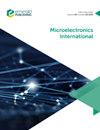A monopole polarisation diversity antenna for high density packaging MIMO applications
IF 0.8
4区 工程技术
Q4 ENGINEERING, ELECTRICAL & ELECTRONIC
引用次数: 0
Abstract
Purpose This paper aims to propose a single element, dual feed, polarisation diversity antenna. The proposed antenna operates from 2.9 to 10.6 GHz for covering the entire ultra-wideband (UWB) frequency range. The antenna is designed for usage in massive multiple input multiple output (MIMO) and closed packaging applications. Design/methodology/approach The size of the antenna is 24 × 24 × 1.6 mm3. The radiating element of the antenna is derived from the Sierpinski–Knopp (SK) fractal geometry for miniaturization of the antenna size. The antenna has a single reflecting stub placed between the two orthogonal feeds, to improve isolation. Findings The proposed antenna system exhibits S11 < −10 dB, S21 < −15 dB and stable radiation characteristics in the entire operating region. It also offers an envelope correlation coefficient < 0.01, a diversity gain > 9.9 dB and a capacity loss < 0.4 bps/Hz. The simulated and measured outputs were compared and results were found to be in similarity. Originality/value The proposed UWB-MIMO antenna has significant size reduction through usage of SK fractal geometry for radiating element. The antenna uses a single radiating element with dual feed. The stub is between the antenna elements which provide a compact and miniaturized MIMO solution for high density packaging applications. The UWB-MIMO antenna provides an isolation better than −20 dB in the entire UWB operating band.用于高密度封装MIMO应用的单极极化分集天线
目的设计一种单元件双馈极化分集天线。拟议的天线工作在2.9至10.6 GHz,覆盖整个超宽带(UWB)频率范围。该天线设计用于大规模多输入多输出(MIMO)和封闭封装应用。设计/方法/方法天线尺寸为24 × 24 × 1.6 mm3。天线的辐射单元来源于Sierpinski-Knopp (SK)分形几何,以实现天线尺寸的小型化。天线在两个正交馈电之间有一个单一的反射短段,以提高隔离。结果:该天线系统具有S11 < - 10 dB, S21 < - 15 dB,在整个工作区域具有稳定的辐射特性。它还提供包络相关系数< 0.01,分集增益> 9.9 dB和容量损失< 0.4 bps/Hz。对模拟输出和实测输出进行了比较,发现结果是相似的。独创性/价值所提出的UWB-MIMO天线通过对辐射单元使用SK分形几何来显著减小尺寸。该天线采用双馈单辐射元件。存根位于天线元件之间,为高密度封装应用提供了紧凑和小型化的MIMO解决方案。UWB- mimo天线在整个UWB工作频带内的隔离度优于−20 dB。
本文章由计算机程序翻译,如有差异,请以英文原文为准。
求助全文
约1分钟内获得全文
求助全文
来源期刊

Microelectronics International
工程技术-材料科学:综合
CiteScore
1.90
自引率
9.10%
发文量
28
审稿时长
>12 weeks
期刊介绍:
Microelectronics International provides an authoritative, international and independent forum for the critical evaluation and dissemination of research and development, applications, processes and current practices relating to advanced packaging, micro-circuit engineering, interconnection, semiconductor technology and systems engineering. It represents a current, comprehensive and practical information tool. The Editor, Dr John Atkinson, welcomes contributions to the journal including technical papers, research papers, case studies and review papers for publication. Please view the Author Guidelines for further details.
Microelectronics International comprises a multi-disciplinary study of the key technologies and related issues associated with the design, manufacture, assembly and various applications of miniaturized electronic devices and advanced packages. Among the broad range of topics covered are:
• Advanced packaging
• Ceramics
• Chip attachment
• Chip on board (COB)
• Chip scale packaging
• Flexible substrates
• MEMS
• Micro-circuit technology
• Microelectronic materials
• Multichip modules (MCMs)
• Organic/polymer electronics
• Printed electronics
• Semiconductor technology
• Solid state sensors
• Thermal management
• Thick/thin film technology
• Wafer scale processing.
 求助内容:
求助内容: 应助结果提醒方式:
应助结果提醒方式:


